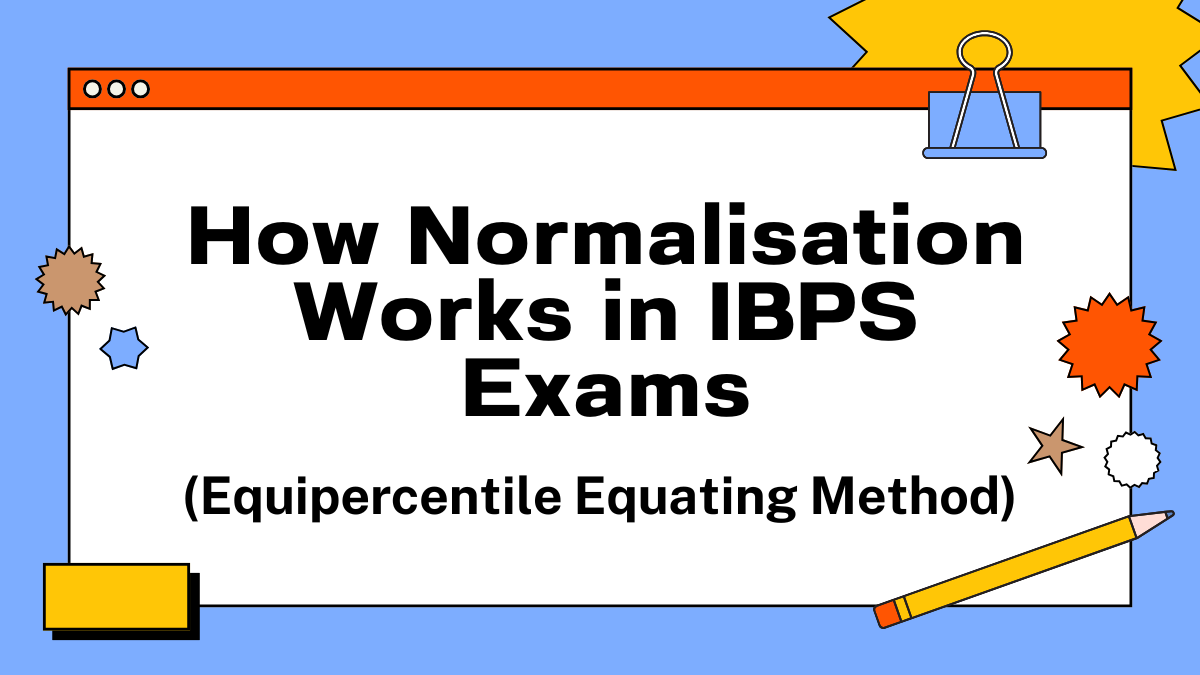In IBPS exams, normalisation is a crucial process used to adjust scores when the exam is conducted in multiple shifts with varying levels of difficulty. Since different candidates appear in different slots, and question paper toughness may vary from one shift to another, the normalisation process ensures fairness and equality in score calculation. It helps to bring all candidates’ scores onto a common scale, making the final merit list more just and unbiased. This method is widely applied in IBPS PO, Clerk, RRB, SO, and other exams to maintain transparency in the selection process.
To ensure that no candidate is unfairly advantaged or disadvantaged by the shift they appeared in, IBPS uses a method called Equipercentile Equating, i.e. normalisation, to adjust the scores across all sessions.
Normalisation in IBPS Exams
In competitive exams with multiple sessions, like those conducted by IBPS, normalisation through equipercentile equating plays a vital role in ensuring fairness. It adjusts for variations in paper difficulty so that all candidates are judged by the same standard. This system not only promotes transparency but also protects candidates from being unfairly impacted by the luck of the draw in shift allocation. Understanding how this works helps candidates trust the process and focus more on preparation than speculation.
Equipercentile Equating for IBPS Exams
Equipercentile equating is a statistical technique used to make scores from different test forms (i.e., question papers) comparable. It ensures that a score in one test reflects the same performance level or percentile rank as a score in another. The IBPS has officially published the exact formula, the logic based on percentile ranking, where candidates’ performance is compared across all shifts to arrive at a fair final score. This ensures no candidate is disadvantaged due to an easier or tougher shift.
IBPS Normalisation Formula
IBPS uses a statistical technique called the “Equi-percentile Method” for normalisation. Under this method, the raw scores obtained by candidates in different shifts are converted into standardised scores. The formula takes into account the average score and standard deviation of each shift to calculate the adjusted score. The Equipercentile score is determined by:
Ye = FY-1(FX(X))
Where,
Ye = same percentile in their respective distribution
FY-1 = inverse of the cumulative distribution function of Test from B
X be the raw scores from Test A
Y be the raw scores from Test B
FX(X) & FY(Y) represent the cumulative distribution functions of X & Y, respectively.
For instance, if a candidate scoring 60 in Shift 1 is at the 80th percentile, and another candidate in Shift 2 is also at the 80th percentile, their scores are equated, regardless of differences in paper difficulty. This method ensures that all candidates are ranked fairly, even if the exams they attempted weren’t identical in difficulty.
How Normalisation Works in IBPS Exams
IBPS follows a structured approach to applying equipercentile equating during score normalisation:
- Score Distributions are calculated for each shift to understand how candidates performed overall.
- Smoothing Techniques are applied using statistical models (like log-linear models) to reduce random noise and anomalies.
- One session is selected as the base shift for comparison.
- Percentile ranks of scores are calculated within each shift.
- For every score in a given shift, a corresponding equivalent score is identified in the base shift using percentile matching.
- These adjusted scores are used for merit listing and selection.
Here are a few examples with explanations to help better understand how equipercentile equating works in IBPS exams and how it ensures fairness across multiple shifts:
Example 1: Equal Percentile, Different Raw Scores
Let’s assume two candidates appeared in different shifts of the same IBPS exam.
- Candidate A (Shift 1) scored 47 marks
- Candidate B (Shift 2) scored 49 marks
Now, based on how other candidates performed:
- Candidate A’s percentile in Shift 1 = 88th percentile
- Candidate B’s percentile in Shift 2 = 88th percentile
Since both are at the same percentile, their performance is considered equal, even though their raw scores differ. IBPS will equate the scores so both candidates are given the same normalised score, say 50 marks. Even if Shift 2’s paper was easier and had more high scorers, percentile comparison ensures both candidates are evaluated fairly based on peer performance.
Example 2: How a Lower Raw Score Can Become Higher After Normalisation
Suppose:
- Shift A had a tougher Quant section and fewer high scores.
- Shift B was slightly easier and saw more candidates scoring higher.
Now consider:
- Candidate X in Shift A scores 42 marks, which places them in the 90th percentile
- Candidate Y in Shift B scores 46 marks, but is only in the 85th percentile
Although Candidate X scored less in raw marks, they performed better relative to their shift.
After equipercentile equating, Candidate X may receive a normalised score of 53, while Candidate Y may get 51.
This shows that percentile rank, not just raw score, is what IBPS focuses on while determining final merit.
Example 3: Small Difference in Percentiles, Large Impact on Normalised Scores
Let’s take:
| Candidate | Shift | Raw Score | Percentile | Normalised Score |
| A | 1 | 38 | 72nd | 42 |
| B | 2 | 41 | 75th | 44 |
| C | 3 | 40 | 80th | 47 |
Here, a small jump in percentile (from 72nd to 80th) leads to a noticeable increase in normalised scores. This is because percentile ranks reflect relative performance, and even a few percentile points can reflect a big leap in performance within a tightly packed distribution.
Example 4: Score Matching Using Percentile Rank
Let’s say Shift A has this distribution:
| Raw Score | Percentile Rank |
| 35 | 65th |
| 40 | 75th |
| 45 | 85th |
And Shift B has:
| Raw Score | Percentile Rank |
| 37 | 65th |
| 42 | 75th |
| 48 | 85th |
If a candidate scores 40 in Shift A, they’re at the 75th percentile.
To equate this score, IBPS looks at what score in Shift B corresponds to the 75th percentile, which is 42.
So, 40 (Shift A) becomes 42 after normalisation, based on percentile matching.




 SEBI Grade A Admit Card 2025-26 Out @seb...
SEBI Grade A Admit Card 2025-26 Out @seb...
 IBPS PO 2026 Exam Date, Eligibility, Sel...
IBPS PO 2026 Exam Date, Eligibility, Sel...
 JAIIB Study Material 2026, Download Subj...
JAIIB Study Material 2026, Download Subj...







